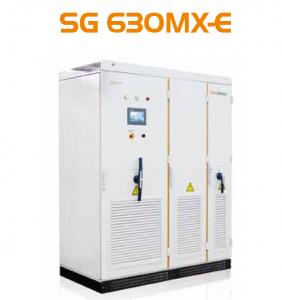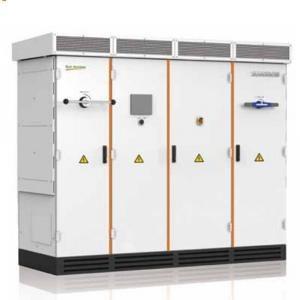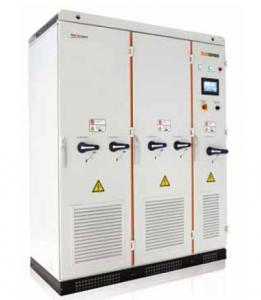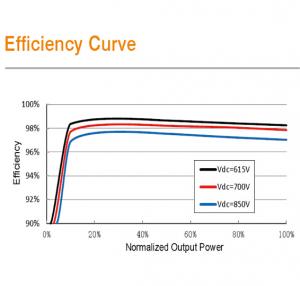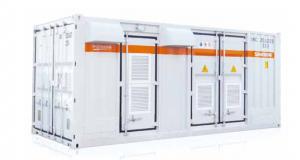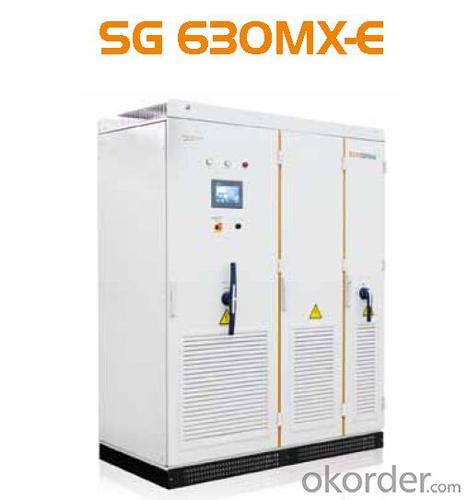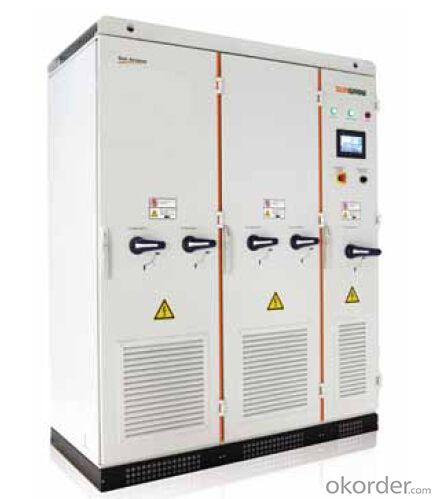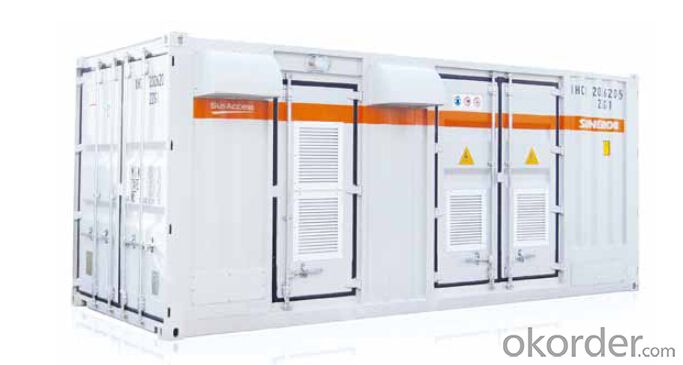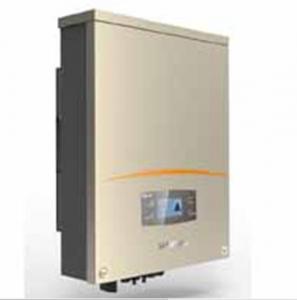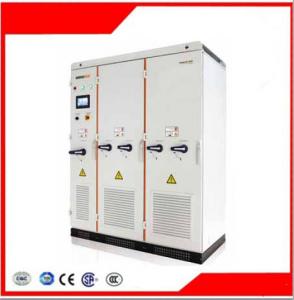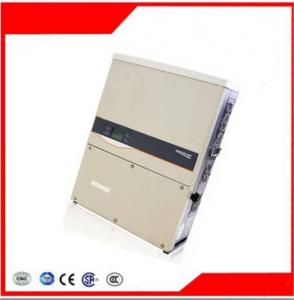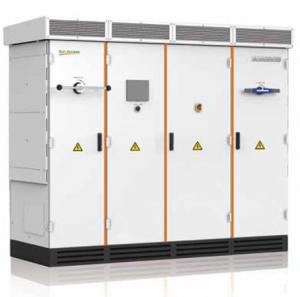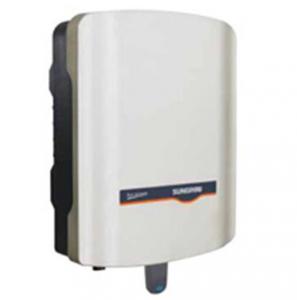Photovoltaic Grid-Connected Inverter SG630MX-E Solar Inverter
- Loading Port:
- China Main Port
- Payment Terms:
- TT or LC
- Min Order Qty:
- 10 unit
- Supply Capability:
- 1000 unit/month
OKorder Service Pledge
OKorder Financial Service
You Might Also Like
1. Structure of Photovoltaic Grid-Connected Inverter SG630MX-E Description
A solar inverter, or PV inverter, or Solar converter, converts the variable direct current (DC) output of a photovoltaic (PV) solar panel into
autility frequency alternating current (AC) that can be fed into a commercial electrical grid or used by a local, off-grid electrical network.
It is acritical BOS–component in a photovoltaic system, allowing the use of ordinary AC-powered equipment.
Solar inverters have special functions adapted for use with photovoltaic arrays, including maximum power point tracking and anti-islanding protection.
Suitable for 50Hz/60Hz grid, could be used in Asia, Australia and Europe.
2. Main Features of the Photovoltaic Grid-Connected Inverter SG630MX-E
• LVRT (Zero-voltage Ride-through)
• Active power continuously adjustable (0~100%)
• Reactive power control with power factor from 0.9 lagging to 0.9 leading
• DC input voltage up to 1000V
• Latest 32 bit DSP chip, advanced digital lock-in technique, more quickly and precisely
• -30℃~+55℃ continuously operating at rated power
• Continuously and stably working in high altitude environment
• Auxiliary heater (Optional)
3. Photovoltaic Grid-Connected Inverter SG630MX-E Images
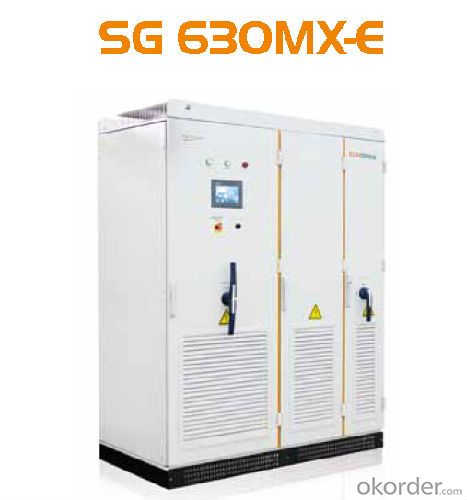
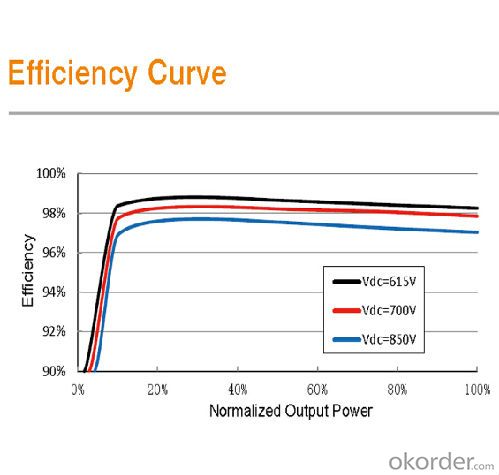
4. Photovoltaic Grid-Connected Inverter SG630MX-E Specification
Input Side Data | |
Max. PV input power | 713KW |
Max. PV input voltage | 1000V |
Startup voltage | 635V |
Min. operation voltage | 615V |
Max. PV input current | 1160A |
MPP voltage range | 615~850V |
No. of DC inputs | 8 |
Output Side Data | |
Nominal AC output power | 630kVA |
Max. AC output apparent power | 700KVA |
Max. AC output current | 1010A |
THD | < 3 % (Nominal power) |
Nominal AC voltage | 400V |
AC voltage range | 320V~460V |
Nominal grid frequency | 50/60Hz |
Grid frequency range | 47~52/57~62Hz |
Power factor | >0.99@default value at nominal power, (adj. 0.9 overexited ~0.9 underexited) |
Isolated transformer | No |
DC current injection | <0.5 %In |
Efficiency | |
Max. efficiency | 98.60% |
Max. European efficiency | 98.50% |
Protection | |
Input side disconnection device | DC load switch |
Output side disconnection device | AC load Switch |
DC overvoltage protection | Yes |
AC overvoltage protection | Yes |
Grid monitoring | Yes |
Ground fault monitoring | Yes |
Over temperature protection | Yes |
Insulation monitoring | Yes |
Surge arrester for auxiliary supply | Yes |
General Data | |
Dimensions(W×H×D) | 1606×2304×860mm |
Weight | 1700kg |
Operating ambient temperature range | -30~65℃(>55℃ derating) |
Night power consumption | <100W |
External auxiliary supply voltage | 400V |
Cooling method | Temperature controlled air-cooling |
Ingress protection rating | IP21 |
Allowable relative humidity range | 0~95% no condensing |
Max. operating altitude | 6000m (>3000m derating) |
Fresh air consumption | 4500 m3/h |
Display | Colored touch screen |
Communication | RS485/Modbus, Ethernet(Opt.) |
5. FAQ of Photovoltaic Grid-Connected Inverter SG630MX-E
Q1. What is the difference between inverter and solar inverter?
A1. Inverter only has AC inpput, but solar inverter both connect to AC input and solar panel, it saves more power
Q2. What is the difference between MPPT&PWM?
A2. MPPT has higher efficiency, it can track the max power point and won't waste energy.
- Q: What is the role of anti-islanding protection in a solar inverter?
- The role of anti-islanding protection in a solar inverter is to ensure the safety of utility workers and prevent damage to the electrical grid during a power outage. It detects when the grid goes down and immediately disconnects the solar inverter from the grid, isolating it to prevent any power from flowing back into the grid. This prevents the phenomenon known as islanding, where the solar system continues to generate power and creates a potential danger for utility workers who may be working on the lines believing they are de-energized. By disconnecting from the grid, anti-islanding protection helps maintain the stability and integrity of the electrical system.
- Q: Can a solar inverter convert DC power to AC power during a power outage?
- No, a solar inverter cannot convert DC power to AC power during a power outage. Solar inverters rely on the grid for synchronization and voltage reference, so when there is a power outage, the inverter automatically shuts down to prevent back-feeding electricity into the grid and endangering utility workers.
- Q: PV grid-connected inverter can directly load it?
- Grid-connected inverter is usually equipped with island protection function, can only receive the power grid, if the load directly, the output is disconnected.
- Q: How does a solar inverter communicate with other devices in a solar power system?
- A solar inverter communicates with other devices in a solar power system through various communication protocols and interfaces. One common method is through wired connections using communication interfaces such as RS485 or Ethernet. These interfaces allow the inverter to establish a direct connection with other devices such as solar panels, batteries, and monitoring systems. In addition to wired connections, wireless communication methods are also used. This includes technologies like Wi-Fi, Zigbee, or Bluetooth, which enable the inverter to connect with other devices within a certain range. Wireless communication is often used for monitoring and control purposes, allowing users to remotely access and manage their solar power system. The communication between the solar inverter and other devices is crucial for the overall performance and efficiency of the solar power system. It enables the inverter to receive important data from the solar panels, such as voltage, current, and temperature, which is necessary for optimal power conversion. The inverter can then adjust its operations based on this information to maximize the power output and ensure system safety. Furthermore, communication with other devices like batteries allows the solar inverter to manage the charging and discharging cycles, optimizing energy storage and utilization. This ensures that excess energy generated by the solar panels is efficiently stored in the batteries and used during periods of low sunlight. Overall, the communication capabilities of a solar inverter play a crucial role in the integration and coordination of different components within a solar power system. It enables efficient power conversion, monitoring, and control, ultimately maximizing the performance and benefits of solar energy generation.
- Q: Can a solar inverter be used with concentrated photovoltaic thermal systems?
- Yes, a solar inverter can be used with concentrated photovoltaic thermal (CPVT) systems. CPVT systems combine the use of concentrated solar power (CSP) and photovoltaic (PV) technologies, where sunlight is concentrated onto PV cells to generate electricity while also capturing heat for thermal applications. Solar inverters are essential components in PV systems as they convert the generated DC electricity into usable AC electricity for grid connection or local consumption. Therefore, a solar inverter is necessary to convert the DC electricity produced by the PV cells in a CPVT system into AC electricity for practical use.
- Q: Can a solar inverter be used in conjunction with a power factor correction device?
- Yes, a solar inverter can be used in conjunction with a power factor correction device. The power factor correction device helps to improve the power factor of the electrical system, ensuring efficient and reliable operation. By installing a power factor correction device in combination with a solar inverter, the overall power quality can be enhanced, leading to optimized energy utilization and reduced electricity costs.
- Q: How does a solar inverter handle power quality issues in the grid?
- A solar inverter helps to handle power quality issues in the grid by continuously monitoring the voltage and frequency of the grid. If it detects any variations or deviations from the standard levels, it adjusts its own output accordingly to maintain a stable and reliable power supply. Additionally, some advanced solar inverters also incorporate features like power factor correction and voltage regulation to further enhance power quality and ensure efficient utilization of the solar energy generated.
- Q: Can a solar inverter be used for off-grid applications?
- Yes, a solar inverter can be used for off-grid applications. Off-grid systems typically rely on solar panels to generate power, and a solar inverter is used to convert the direct current (DC) produced by the panels into alternating current (AC) which can be used to power appliances and devices. The inverter also helps regulate the flow of electricity and ensure compatibility with off-grid power storage systems such as batteries.
- Q: What is the power factor correction capability of a solar inverter?
- The power factor correction capability of a solar inverter refers to its ability to adjust the power factor of the electricity it produces. A power factor is a ratio that measures the efficiency of electrical power usage, with a value between 0 and 1. A solar inverter with good power factor correction capability can optimize the power factor towards unity (1), which indicates maximum efficiency. This helps in minimizing reactive power and reducing energy wastage, resulting in a more efficient and effective utilization of solar power.
- Q: Can a solar inverter be used in a solar-powered electric vehicle charging station?
- Yes, a solar inverter can be used in a solar-powered electric vehicle charging station. A solar inverter is responsible for converting the Direct Current (DC) generated by solar panels into Alternating Current (AC) that can be used to charge electric vehicles. Therefore, it is an essential component in a solar-powered EV charging station, allowing the electricity generated from solar panels to be compatible with the charging needs of electric vehicles.
Send your message to us
Photovoltaic Grid-Connected Inverter SG630MX-E Solar Inverter
- Loading Port:
- China Main Port
- Payment Terms:
- TT or LC
- Min Order Qty:
- 10 unit
- Supply Capability:
- 1000 unit/month
OKorder Service Pledge
OKorder Financial Service
Similar products
Hot products
Hot Searches
Related keywords
